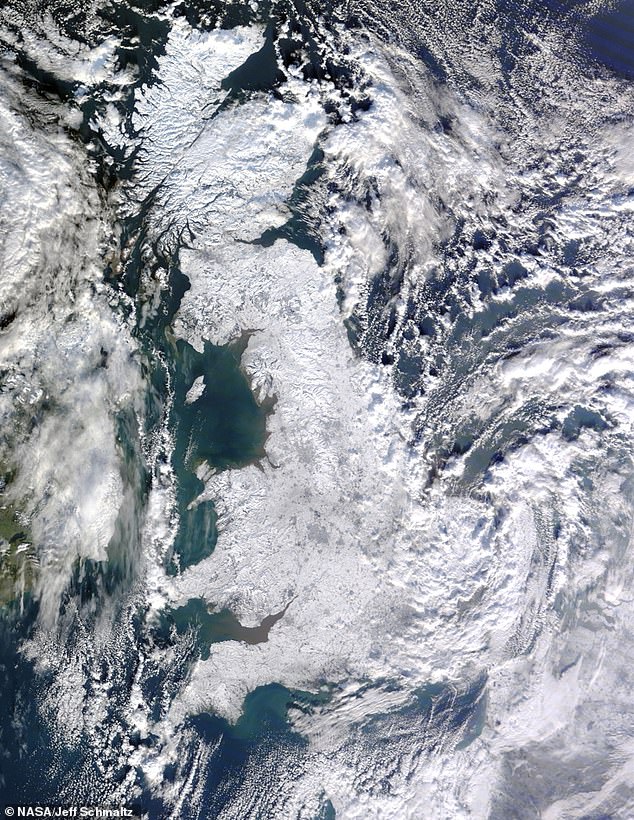Scientists have warned that the Gulf Stream is on the verge of collapsing – a disastrous event that could plunge the northern hemisphere into a new ice age.
The researchers from China and San Diego have uncovered a ‘key fingerprint’ hidden below the ocean’s surface that suggests it has been weakening for decades.
The ‘distinctive temperature fingerprint’ is at ‘mid-depth’ – 3,280ft to 6,560ft (1,000-2,000 metres) below the ocean’s surface – and it could point to a collapse later this century.
The Gulf Stream is only a small part of a much wider system of currents, officially called the Atlantic Meridional Overturning Circulation or AMOC.
Described as ‘the conveyor belt of the ocean’, it transports warm water near the ocean’s surface northwards from the tropics up to the northern hemisphere, keeping Europe, the UK and the US east coast relatively mild.
The engine of this conveyor belt is off the coast of Greenland, where, as more ice melts from climate change, more freshwater flows into the North Atlantic and slows everything down.
Worryingly, if the AMOC does collapse, it could plunge large parts of Europe into a deep freeze.
In fact, scientists have predicted that parts of the UK could drop to as low as -30°C.

The AMOC already slowed down in the late 20th century, say the researchers, but the temperature anomaly could become more pronounced as the century progresses
Climate scientists generally agree that the AMOC brings enough warmth to the northern hemisphere to keep it relatively mild.
So if it were to slow down or even collapse, large parts of Europe and North America could be plunged into a deep freeze.
Already, climate models have predicted a decline in the AMOC’s strength linked to the release of greenhouse gases caused by human activity.
However, ‘debate remains on whether and when this circulation has slowed’ over the past century, claim the team from Institute of Oceanology of the Chinese Academy of Sciences (IOCAS), who worked with experts from University of California, San Diego.
For their study, the scientists analysed past observational data, climate models and ocean simulations to track the AMOC 75 years into the future.
They uncovered the ‘observationally detectable fingerprint’ in the North Atlantic Ocean’s mid-depth where temperatures were found to be surprisingly warm – a signal that an AMOC slowdown is in progress.
‘Here we identify a distinctive temperature fingerprint in the equatorial Atlantic that signals the Atlantic Meridional Overturning Circulation change,’ they say.
‘The robust physical mechanism and reliable detection make [this fingerprint] a valuable metric for AMOC monitoring in a warming climate.’

The scientists identified a ‘distinctive temperature fingerprint’ in the equatorial Atlantic at mid-depth that signals change to the Atlantic Meridional Overturning Circulation (AMOC)
Next, the team used the Massachusetts Institute of Technology General Circulation Model (MITgcm), a computer model that simulates the ocean, atmosphere and climate.
Using MITgcm allowed them to trace how ‘AMOC-related signals’ such as energy waves spread rapidly toward the equator.
Results showed that an AMOC slowdown triggers subsurface warming in the subpolar North Atlantic – the area between the subtropics to the south and the Nordic Seas to the north.
This warming then generates energy waves known as ‘baroclinic Kelvin waves’, which travel towards the equator along the western boundary of the North Atlantic.
Upon reaching the equator, these waves propagate along the equatorial region, ultimately causing warming at mid-depth (3,280ft to 6,560ft).
Further analysis using climate models confirmed that this mid-depth warming is ‘highly correlated’ with AMOC changes over the coming decades, according to the projections.
The researchers also point out that by examining observational data dating back to 1960, they’ve identified a clear mid-depth warming trend that has stood out since the early 2000s, suggesting that the AMOC likely began to weaken (slow down) in the late 20th century.
Importantly, temperature variations at mid-depth are a more reliable indicator of the AMOC’s strength than temperatures at the water’s surface, which are more easily affected by atmospheric variability caused by factors such as solar radiation and volcanic eruptions.

Scientists think AMOC brings enough warmth to the northern hemisphere that without it, large parts of Europe could enter a deep freeze. This remarkable satellite picture showing the extent of snow across Britain on January 7, 2010 gives an idea of what this could be like
‘Most of the existing indices of AMOC intensity rely on the surface or near-surface properties, which are easy to measure but are strongly influenced by internal climate variability,’ the team explain.
‘The new proxy proposed here complements existing surface proxies and allows a more reliable diagnosis of AMOC change, to the best of our knowledge.’
The study, published in Communications Earth & Environment, warns that the equatorial Atlantic ‘serves as a critical crossroads’ for the AMOC.
If AMOC slows down too much, it could lead to dramatic regional climate change. Northern Europe would experience extreme cooling of up to 15°C, causing winter temperatures to plunge, overriding the warming driven by human activity.
Meanwhile, rainfall and weather patterns across the tropics and subtropics either side of the equator would move and intensify.
Jonathan Bamber, a professor of Earth observation at the University of Bristol, said the climate of northwest Europe would be ‘unrecognisable compared to what it is today’.
‘It would be several degrees cooler so that winters would be more typical of Arctic Canada and precipitation would decrease also,’ he told the Daily Mail. ‘Very harsh, cold winters would certainly be a threat to life.’
